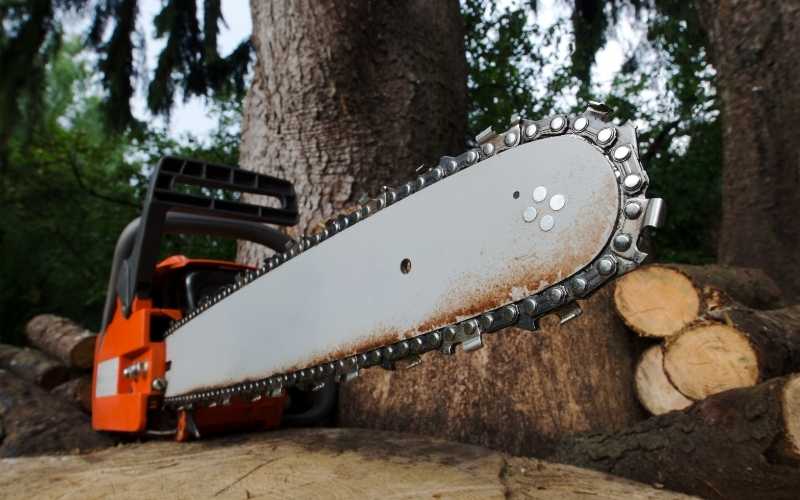When a professional handles and uses a chainsaw, it’s beautiful to watch the way the saw cuts almost effortlessly through the wood, and how chips blow off from it.
However, another important thing you notice right away is that’s it’s a very powerful machine that cuts through and damages almost anything in its part. If it cuts through wood like that, just imagine what it can do if it accidentally comes in contact with the user.
Yet, according to the CDC, approximately 36,000 people are treated in hospital emergency departments for injuries from using chainsaws. That’s why, one of the most important things to consider before buying or using one is safety.
It’s very important to operate and maintain it according the manufacturer’s guidelines provided in the manual that comes with it.
Yes, chain saws are very powerful and can be dangerous if handled poorly, but sometimes it’s inevitable to use them. For instance, a big tree in your property might need to be removed, or you might need to prune off large tree branches in your yard. Also, after natural disasters like a hurricane or earthquake, chainsaws are usually used to clear off fallen or partially fallen trees and tree branches from roads and properties.
If you’re a total newbie, sometimes it’s better to hire the services of a professional when removing a tree from your property or when clearing off fallen trees.
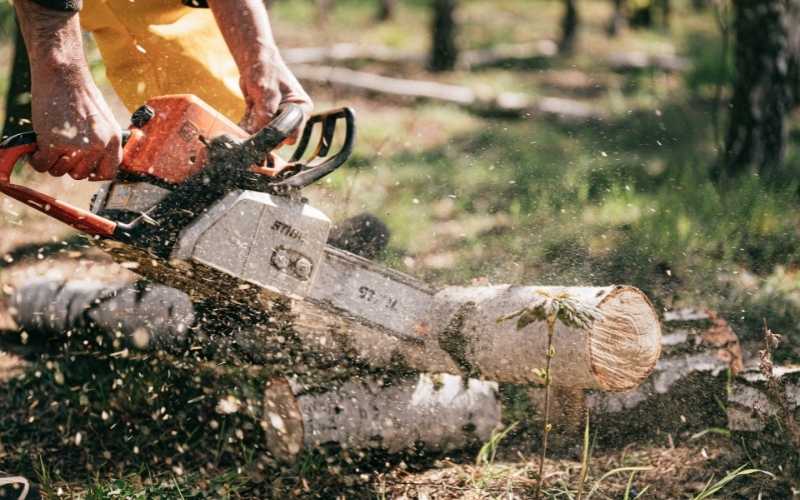
On the other hand if you have to use it yourself, then make sure to learn the ropes from a pro, so you know what you’re doing, follow all safety guidelines and wear proper safety gear (chainsaw chaps).
There’re many uses for chainsaws today, that’s why even though it’s a dangerous piece of machinery, it still sells like hot cakes.
It’s used for felling, limbing and bucking of trees for the purpose of getting timber for construction of houses and also for cutting firewood. So, as a homeowner who uses firewood on a daily basis, a portable unit can come in very handy for bucking tree logs for firewood.
Whether you’re a professional or a simple homeowner looking for a suitable chain saw to cut some firewood or handle some repairs in the yard, this guide contains everything you should know before purchasing one.
Table of Contents
Types of Chainsaws
Unlike when it was first invented around 1918, there are different types of portable chainsaws available today, suitable for different types of applications.
There are units suitable for the average homeowner / yard owner, and there are those for professional tree loggers. Whatever your needs are, here are the different types you can choose from.
High Reach / Rope / Pocket Chainsaw

If you want to cut off high tree limbs and branches without climbing the tree, the high-reach or rope chain saw might just be what you need.
It’s the most basic form of a chain saw. In fact, it’s just the chain without a motor or engine to supply it power. If the tree branch is high above the ground, you can just throw the chain over it and toggle from both sides to and fro to achieve the cut.
This can come in very handy whether you’re a homeowner or you’re out there in the outdoors camping. It can fit right into your backpack without taking up space.
Mini Chainsaw
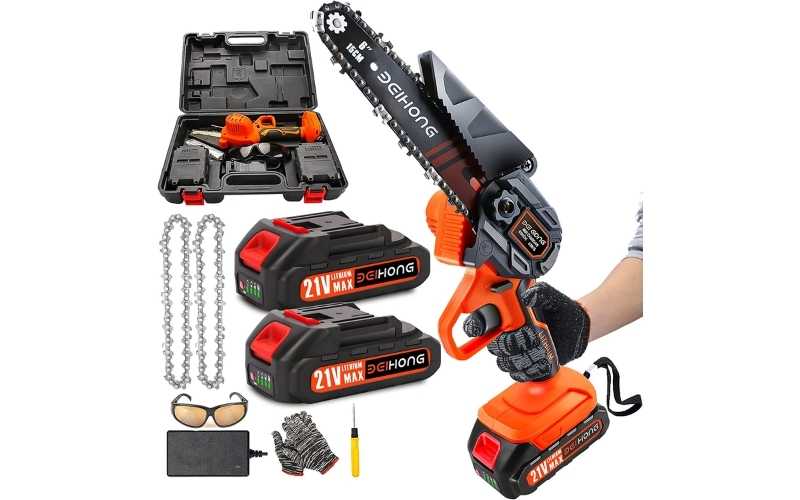
The mini chainsaw is a miniature one-hand operated unit ideally used for cutting and pruning off smaller tree limbs and branches, without having to deal with a bigger, heavier machine.
It will come in handy whether you’re cutting some wood in the backyard for firewood, pruning tree branches or even for simple home renovations.
The one-handed operation makes it super easy and simple to handle, even for a newbie user. They’re usually battery powered, which means it requires little to no maintenance. Just charge the battery, plug it in and get to work.
Related: How To Choose A Telescopic Hedge Trimmer
Gas or Petrol-Powered Chainsaws

Gas or petrol-powered chainsaws are often the most common you’ll find especially among professionals who use them on a daily basis.
They are usually more powerful compared to electric powered units and they cut smoother and faster. You’ll usually find them among pro loggers who use them for felling and bucking large trees.
Unlike battery powered units which will stop running if the battery runs down, gas powered chainsaws will stay running as long as you keep adding gas to the engine.
However, even though they’re more powerful and have many advantages, they also have several noteworthy disadvantages.
First of all, they’re heavier and require more control, especially the ones with longer chain bars. These are usually meant for professional / heavy-duty use.
They’re also very noisy, producing over 106 decibels of noise during use. That’s why it’s always advisable to use ear-muffs when operating one. You can tell from several miles away that someone’s operating a gas chainsaw just by the sound it makes.
They also require regular servicing and maintenance to keep them in tip-top condition.
Starting one up can also be laborious, requiring several yanks of the pull cord, unlike electric units which can be turned on by simply squeezing trigger.
Corded Electric

Corded electric chainsaws as the name implies are powered using electric current from wall outlets. You need to plug them into the wall and in most cases will need an extension cable for longer reach.
They’re lighter, often smaller, and requires no effort to start. Just plug and squeeze the trigger, and you’re in business.
As for noise, they produce very little compared to gas units, and they require less maintenance. There’s no engine to service. All you need to do is lubricate the guide bar and chain from time to time.
Compared to gas units however, they cut slower and are not as powerful. However, they still get the job done especially for light-duty tasks around the yard like cutting tree limbs and bucking small trees.
Battery Powered
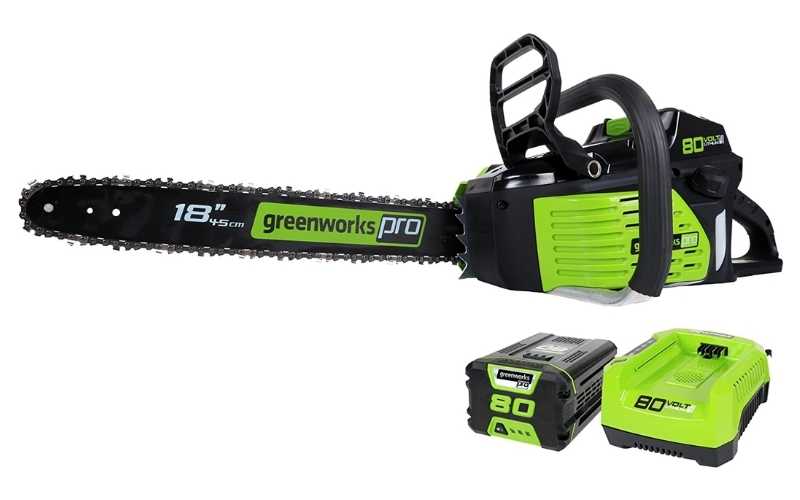
Corded electric chainsaws limit your reach because you can only go as far as the extension cord lets you. With battery powered units however, you’re free of the extension cords and can work wherever you want with the saw.
Some people think they’re very powerful because they’re battery powered. Well, you should think again. Over the past few decades, advancement in battery technology has made cordless tools as powerful as gas powered units. Often, they’re often priced the same.
The only drawback with battery powered tools is run time. Of course, the battery eventually runs down after working for 30 minutes to an hour, and you have to recharge it again. You can increase your runtime by simply having a spare charged battery by the side.
If one runs down, you can start charging that one, and plug in the fully charged spare, and continue cutting with it.
Jawsaw / Alligator Lopper
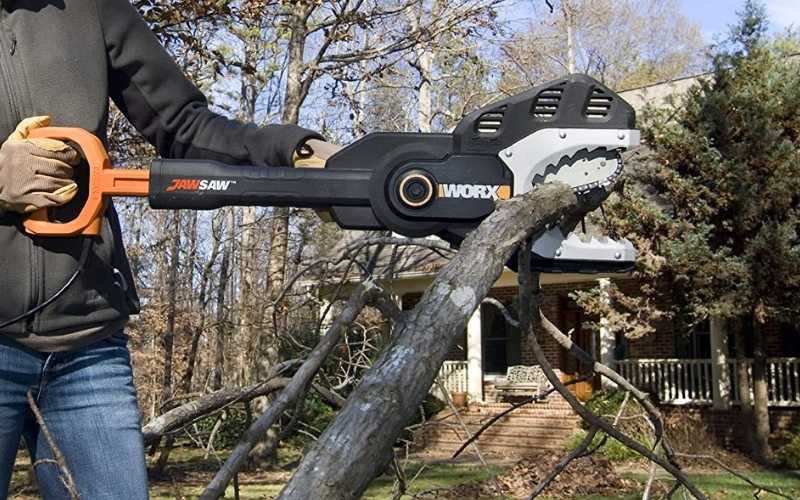
The Jawsaw or the alligator lopper is just a mini chainsaw with the guide bar and chain shielded within two safety jaws.
It’s usually used for pruning tree branches up to 4 or 5 inches in diameter, and not for cutting trees with larger diameter. They’re usually corded electric.
Carpentry Chainsaw
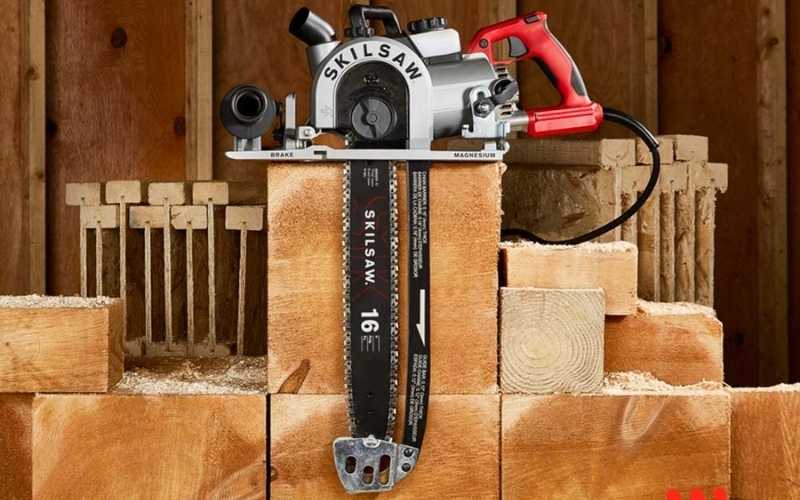
This is designed for carpenters and framers who need a saw to cut through oversize materials such as large framing beams.
Skilsaw produces one of the best ones, maybe the only one you’ll find, which is the SKILSAW SPT55-11 Sawsquatch worm drive carpentry chainsaw.
It’s looks just like a worm drive circular saw, but in place of the circular saw, a 16-inch guide bar and chain are installed for cutting through oversize framing lumber in one pass.
Related: The 7 Best Skilsaw Circular Saws For Craftsmen
Pole Chainsaw
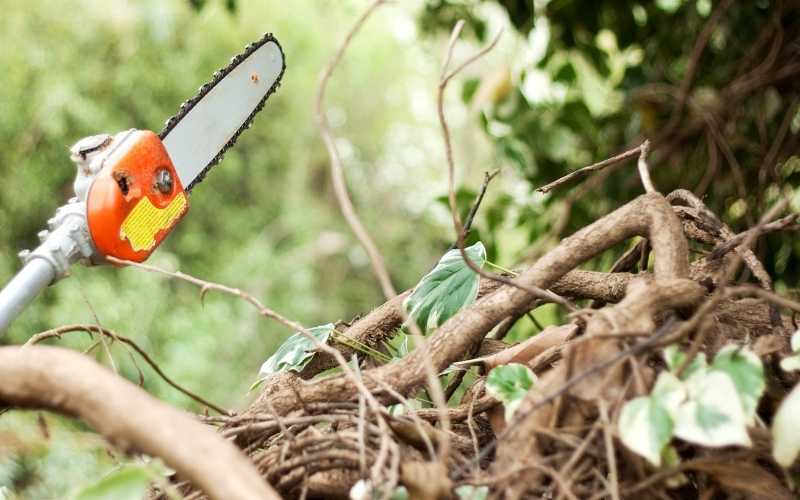
Often called a pole saw, the pole chain saw is a unit built for cutting or pruning branches off tall trees in the yard.
It’s just a regular mini chainsaw with a bar attached for reaching high tree limbs and branches without having to climb the tree or use a ladder. This ensures you don’t have to work with a regular saw from awkward positions up the tree and jeopardize your safety.
Some pole saws are built in a way so that the pole can be detached so the saw can be used like a regular mini chain saw without the extension pole.
Hydraulic Chainsaw
Hydraulic chainsaws are designed to be powered using hydraulic systems, and they have several applications in construction, mining, agriculture and underwater projects where hydraulic power is readily preferred to gas powered machines.
If you’re a simple homeowner who just want to cut down some wood for firewood in the backyard or prune some overgrowing branches off trees in your yard, you don’t need to worry about getting one of these.
Chainsaw Sizes
The size of a chainsaw is usually determined by the size of the guide bar and the engine it comes with. The guide bar is an elongated bar with a round end made of wear-resistant alloy steel. It’s usually 20 to 90 centimeters in length. Most consumer grade chainsaws generally have 20 to 60 cm long guide bars.
Of course, the longer the bar length, the bigger the size of the tree you can cut with it. Smaller units are best for pruning tree limbs, and bucking smaller trees for firewood.
Larger units with longer guide bars between 50 and 90 cm are usually for professional use, for felling and bucking large diameter trees.
The Chain
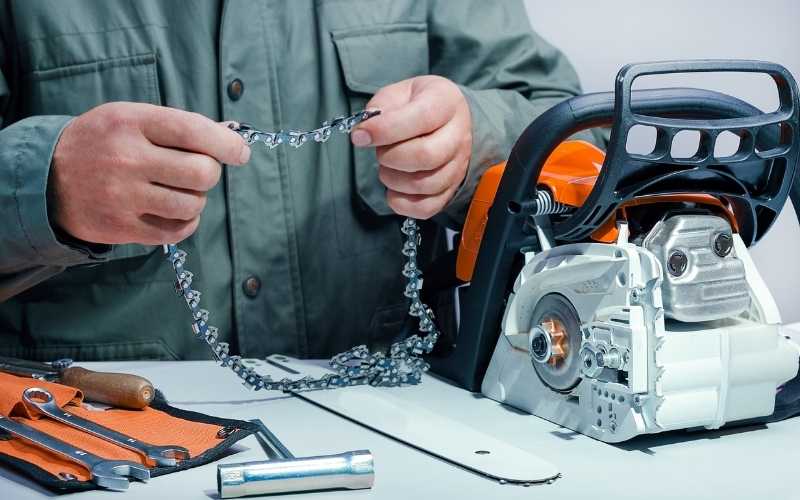
Clearly, one of the most important parts of a chainsaw is the cutting chain. Unlike other saws, chainsaws don’t come equipped with blades. The chains do the cutting.
Just like a bicycle chain, the chains is constructed from riveted metal sections but without the rollers in a bicycle chain. Each segment of the chain is equipped with small, sharp, teeth for cutting through wood.
Each of the tooth is made of chromium-plated steel which makes it very resistant to wear and remains sharp through several uses before needing to be resharpened.
The following are the basic measurements you need to know when buying a new chain.
The Pitch
The first measurement you need to know when buying a new chain is the pitch. This is just half the distance between three consecutive rivets on the chain.
To get the pitch, just take a tape measure and count 3 rivets on the chain, then measure the distance between them, and divide it by 2.
You can also check the guide bar and instruction manual from the manufacturer for these measurements.
The Gauge
The gauge determines whether the chain will fit into the guide bar or not. If you don’t get this measurement correctly, the chain you buy may be too thick to fit into bar or too loose and will not gain traction needed to cut.
The gauge is the thickness of the drive links which fits into the guide bar. It’s measured in inches and it’s usually found on the saw itself or on the instruction manual from the manufacturer.
Generally, there’re 4 different gauge sizes to choose from which are 0.043 inches, 0.50 inches, 0.063 inches and 0.058 inches.
Chain Length
Figuring out the length of the chain that can fit into your guide bar is very important. This will ensure you don’t buy one that’s too long or one that’s too short.
Chains are measured in the number of drive links they have. To figure out yours, you can use the old method of placing a strip of tape on one drive link, and counting your way round the chain to get the number of drive links.
Now having got the pitch of the chain, the gauge and now the length or number of drive links, you can use this information to choose the right chain size for your chain saw.
Safety Features
Chainsaws come built with certain safety features that protects the end user from sustaining any injury while using the saw.
Chain Brake
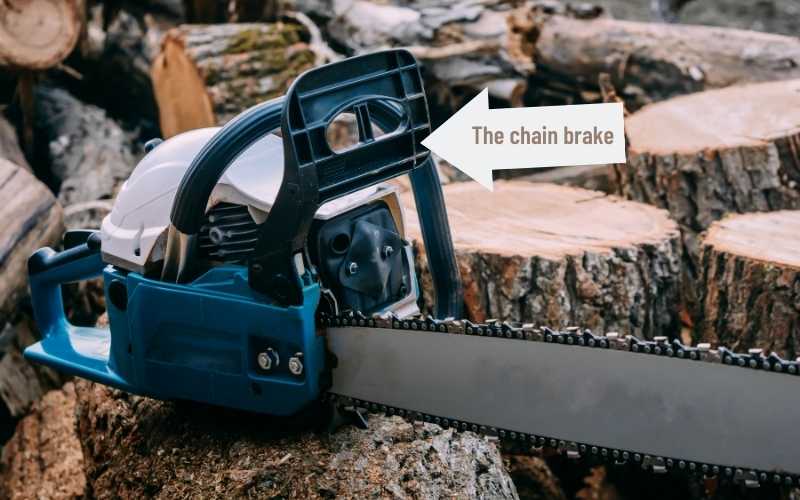
Today, manufacturers can’t sell a chainsaw without this feature. It’s a featured designed to stop the chain within fractions of a second if a kickback occurs.
There’s a paddle located forward of the upper handle that activates the chain brake if a kickback occurs. You can watch this video to see how it works.
Question You Must Ask Yourself To Make The Right Choice
How often will I use the chainsaw?
What’s the maximum size of wood I’ll be cutting with it?
What special features do I need?
What energy option do I want?
What’s my budget?
Can I deal with a noisy one?
How heavy do I want it to be?

